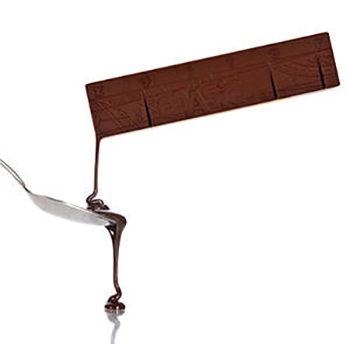For cake batter, mousse and fondue you just have to chop and melt the couverture. How to melt chocolate
For soft chocolate cake icing you just have to melt the couverture and add some cream and honey. See the recipe
If you like to create a thin, glossy chocolate coating, bonbons, chocolate leaves for decorations or a thick sauce to dunk biscuits in, you have to temper the couverture. Just follow the professional tempering instruction
Couverture (from French, meaning "to cover") is especially high-quality chocolate for coating your baked creations. Generally, couverture contains only the best cocoa beans and pure cocoa butter for a truly sophisticated taste. Its slow and careful manufacturing lets the flavour fully unfurl. Thanks to its finely ground texture, it develops a lustrous glaze.
Baking chocolate is easier to use because of its cruder production, containing other fats, like palm oil. It is a simple chocolate for simple baking needs.
But if you want the real chocolate taste, real couverture is a must. Just try it and you will taste the difference!

First things first: KEEP AWAY FROM WATER! As soon as chocolate comes in contact with even a few drops of water (or any other liquid), it will clump. Make sure that all baking utensils are dry and stay dry (watch particularly for the bain-marie's water vapour).
My personal tip: melt chocolate in the oven
Preheat the oven to 50° C (122° F). Use a knife to cut the chocolate into small chunks and put it in the oven in an ovenproof bowl. Stir two or three times and make sure that the chocolate temperature never rises above 45° C (113° F). You may want to use a kitchen thermometer to be sure.
Classic in a double-boiler
Chop the couverture and melt it in a double boiler or bain marie. Create a double boiler by bringing a medium pot filled a little less than halfway with water to a simmer. Place a heatproof bowl that's just big enough to sit on top of the pot and add your chopped chocolate to the bowl. Keep the pot over low heat and stir it well. Be careful couverture should never come into contact with water, otherwise it will form clumps. The processing temperature is at 45 °C (113° F).
Preparation
Cut the chocolate into small chunks, let it melt slowly in a double boiler or bain marie, add the other ingredients and let it cool down. Process the icing at 35–38° C (95–100° F).
Icing recipes:
100% dark chocolate icing
70% dark chocolate icing
50% milk chocolate icing
40% milk chocolate icing
White chocolate icing
Almond praline icing
Hazelnut praline icing
Coffee couverture icing
Caramel couverture icing
Chocolate has to be tempered to achieve a thin, glistening chocolate icing, to create bonbons, chocolate decorations or to dip cookies. This may sound complicated but, with a little practice, it's rather easy.
IMPORTANT:
Keep away from water: As soon as chocolate comes in contact with even a few drops of water (or any other liquid), it will clump. Make sure that all baking tools are dry and stay dry (despite the bain-marie's water vapour).
You will need a thermometer to check the temperature. Chocolate must never be allowed to cool abruptly, or to be heated too rapidly, or it will lose its lustre.
Make sure to use the right temperature according to the type of chocolate.
Dark chocolate 31–32° C (88–90° F)
Milk chocolate 30–31° C (86–88° F)
White chocolate 29–30° C (84–86° F)
Pro tip: you can also cool down your chocolate and reach the right temperature more quickly by stirring it in a cold bain-marie. Et voilà!
Try to keep the temperature steady. As soon as the chocolate has cooled by 2° C (about 3.5° F), reheat it carefully, stir and continue using it. Check the temperature regularly. (Keep away from water!)
Super secret trick – which always works, we swear
Just add up to 5 % of high-quality cooking oil. Trust us! By adding oil, keeping the right temperature is less important and your couverture will always be shiny. Please don't use regular butter because it contains water!
No blooming!
The whitish film, or "bloom", which cookies or chocolates sometimes get, comes from wrong tempering (see above) or storing them in a warm place. If the chocolate gets too warm during processing, the cocoa butter will rise to the surface, where it congeals and creates a white, matte film. But don't despair! Your creations may not look as great but they are still a thousand times more delicious than if you had been using ordinary baking chocolate.